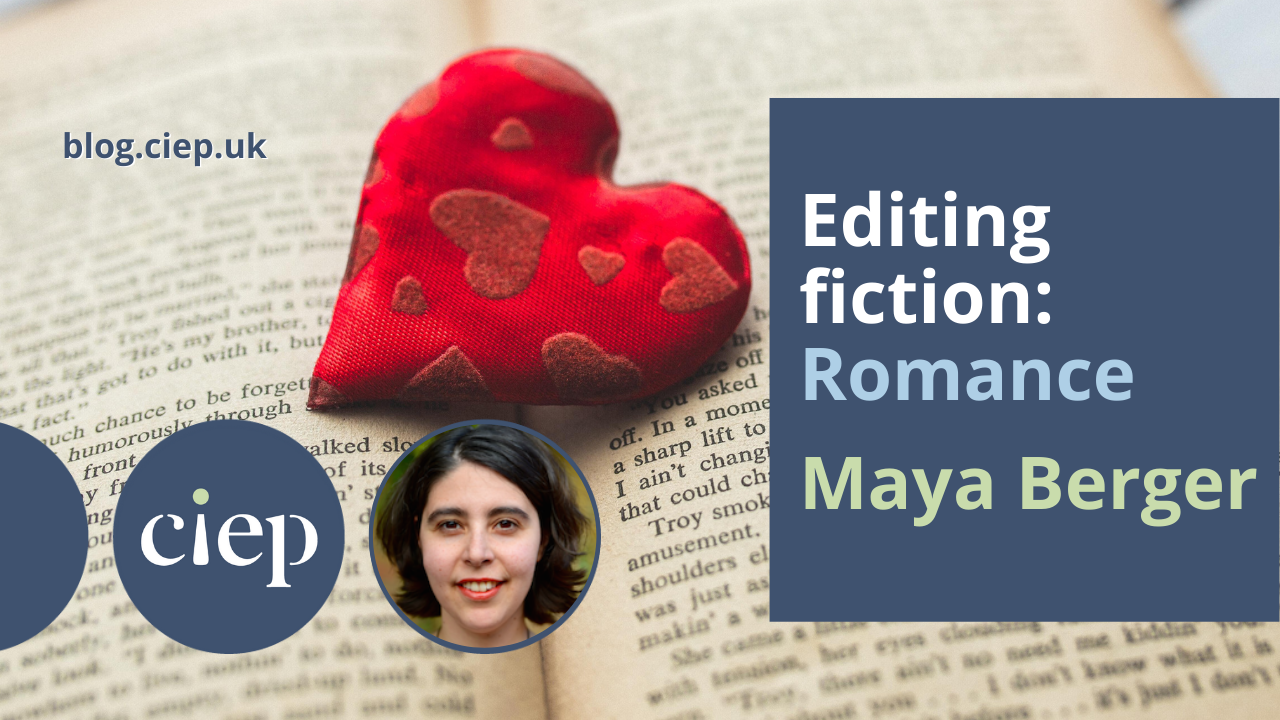In this post, Maya Berger looks at how fiction editors can help authors to create romantic relationships that feel true to the rest of the story.
Content warning: general mention of non-consensual relationships and dynamics in fiction (no specific examples).
Characters in a work of fiction are complex creatures. They have personalities, back stories, motivations, physical appearances, schedules and interpersonal relationships – and a line editor needs to make sure that all these details are consistent, realistic within the fictional universe and engaging for the reader throughout the story. Add a romance into the mix, and now the editor also has to consider things like characters’ attitudes towards dating, sex and gender roles in relationships; whether the character becomes unrecognisable once they’re in love; and representations of consent.
This post will look at some of the major character considerations for editors to keep in mind when line editing romance and intimacy in fiction. It offers tips on ensuring that a story’s romantic elements preserve character consistency, framing and inclusivity, and handling consent issues sensitively.
Meet the lovebirds
When we’re line editing fiction in general, we look for well-developed, consistent characters with clear motivations, relatable thoughts and actions, and realistic and satisfying character arcs. And we can apply the same criteria to romantic character arcs and intimate dynamics.
What does the story say about the characters in a couple (or throuple, or other polyamorous configuration, as the case may be)? If your author has supplied character sketches, you’ve got a head start on this; otherwise, as you edit, note details like:
- what qualities they value in their loved ones
- how they react to stress
- how highly they prioritise their career
- how they like to spend their free time
and ask yourself whether the characters show these traits in their romantic interactions.
Then, look at what the romance contributes to the reader’s engagement with the characters. Does a romantic dynamic add to character development and reveal hidden truths about a character? Does a character’s crush motivate them to perform the actions that drive the plot forward, or does a character’s behaviour within a romantic relationship reveal an ulterior motive of theirs? If the answer to all these questions is ‘no’, or if the romantic dynamics feel out of place or tacked on just to give a character something to do, query this with the author.
There are often little additions you can suggest to turn an isolated intimate moment into a scene that adds depth to the story. For example:
Before: ‘She kissed Ilana, losing herself in the sensations.’
After: ‘She kissed Ilana, losing herself in pleasurable sensations for the first time since the war began.’
Before: ‘If the heart-stoppingly beautiful barista was working today, he would finally ask them out.’
After: ‘If the heart-stoppingly beautiful barista was working today, he would finally ask them out – he was determined that his infernal stutter would not get in the way this time.’
Editing romance for character consistency
Be on the lookout for unexplained inconsistencies between how a character acts, speaks and thinks in romantic and non-romantic scenes. If you find any, ask the author about them.
Here’s an example of a query with suggestions for addressing such a character inconsistency:
Character A’s flirting is playful, but in all his interactions with his friends and siblings he is intense and pretentious, and readers may find the difference jarring. If there is something about Character B that brings out Character A’s hidden playful side, please make this clearer in the text.
I’d also suggest having Character A notice the difference in himself and react to it: is he ashamed to be letting his guard down around Character B, for example, or does it make him appreciate Character B all the more? Alternatively, you could add some light-heartedness to Character A’s other relationships or make him more intense with his lover so that he’s still recognisable in every scene.
With this query, I’ve prompted the author to consider how they intended to portray Character A in the context of their romantic and other relationships, and I’ve given them some corresponding options for improving the text.
Editing romance for consent orientation
The Pervocracy states that, ‘A consent culture is one in which the prevailing narrative of sex – in fact, of human interaction – is centred around mutual consent.’
When examining the romantic dynamics in a story, try to establish the story’s consent orientation – its underlying attitudes and assumptions about the seeking and granting of consent. For example, the author may have written dialogue with a joke about following someone home that they intended as flirty banter but that comes across like a lyric from ‘Every Breath You Take’. In a case like this, you can suggest having the character sheepishly realise what they’ve implied and apologise for being creepy, framing the character as a villain and having other characters react negatively to the joke, or replace the joke with a different funny line that doesn’t rely on making someone feel unsafe for its punchline.
The vocabulary and tone play a big part in setting a story’s consent orientation: for example, is the author trying to create an atmosphere that is inappropriately erotic when a character is showing reluctance or distress? And ask yourself which characters are portrayed sympathetically. The answers to these questions will help you determine the story’s position on consent and whether the author is being exploitative, not just in terms of the romantic elements of the story but with all the story’s interpersonal relationships.
As an editor, you may encounter scenes of non-consensual or traumatic relationships and acts, particularly in crime fiction, horror and historical fiction. Sometimes these scenes will be integral to a character’s story or establishing historical accuracy and realism, but you can always choose not to take on a project with these elements or step away from a project that you’re uneasy about.
When editing a story with non-consensual elements, I suggest advising the author to add a content-warning disclaimer in the front matter of the story to help readers know what to expect, if it’s not already clear from the cover, the blurb or the genre and marketing of the book.
Even though the inclusion of a non-consensual scenario might be necessary in a story, that doesn’t give an author carte blanche to glorify coercion or violence in an intimate relationship, and an editor can suggest rewording or reframing a character or scene to avoid glamourising these things the same way that we might for murder, fraud or any other crime. This brings us on to …
Editing romance for character framing
As well as the non-consensual dynamics mentioned above, even within the realm of consensual relationships there is potential for misogyny, jokes in poor taste, gender essentialism and other content that can alienate readers. Again, note the characters’ reactions to each other and to what is happening, as well as how the narrator treats the characters. Do the sympathetic characters’ actions and dialogue support the framing of them as swoon-worthy?
For example, if Character D describes Character C as ‘the woman of my dreams’, but this ‘dream woman’ constantly insults and belittles Character D in front of their friends, do the narration and the other characters also see Character C positively? If they do, you can raise a query with the author, along the lines of:
Character C insulted Character D in front of their friends seven times in the previous two chapters. This doesn’t seem consistent with the description of her as ‘the woman of my dreams’, with how well liked she is within their friend group, or with the narration’s framing of her as a sympathetic character.
To avoid putting off readers, consider having fewer instances of Character C insulting her partner and/or having Character C apologise and make good-faith efforts to change. Alternatively, you can reframe Character C’s actions by giving them consequences within the story, such as having Character D or their friends call out Character C and telling her that her behaviour is unacceptable.
Editing romance for inclusivity
The traditional male romantic leads in Western fiction (tall, white, non-disabled, young, cisgender men who were sexually attracted to women) and their female counterparts (cisgender, young, non-disabled, white, and seeking a monogamous romantic and sexual relationship with a man) leave a lot of readers unrepresented.
Thankfully, as many fiction genres have become more diverse, so have the romances within them. And as editors, we can encourage authors to include positive representation in their stories by moving beyond stereotypes or subverting them.
When characters with romantic storylines are from racialised or sexual-minority backgrounds, or when they are older characters or characters with impairments, illnesses or neurodivergence, challenge any negative stereotyping around things like:
- their capacity to feel and express desire
- their attitudes towards casual sex, having and raising children, and LGBTQIA+ relationships
- the gender roles they occupy.
Conclusion
- Get to know the characters with romantic storylines, and note whether they show the same traits in their romantic interactions and in the rest of the story.
- Establish the story’s consent orientation and pay attention to how the dialogue, tone and character framing reinforce it.
- Encourage positive representation of diverse romances and challenge negative stereotyping.
Further reading
To find out more about integrating romance into a work of fiction, check out Candida Bradford’s blog post on writing a romantic subplot, TV Tropes’ Romantic Plot Tumor page, this blog post from KJ Charles on consent in sex scenes and my blog post on how to write more diverse sexuality in fiction.
About Maya Berger
Maya Berger is an Advanced Professional Member of the Chartered Institute of Editing and Proofreading. She specialises in editing and proofreading erotic and romantic fiction, speculative fiction, and academic texts in the humanities and social sciences, and she appeared as a guest on The Editing Podcast speaking about editing erotica. Maya also launched The Editor’s Affairs (TEA) in 2020 to help fellow freelance editors manage their business affairs. She lives and works in Toronto, Canada.
 About the CIEP
About the CIEP
The Chartered Institute of Editing and Proofreading (CIEP) is a non-profit body promoting excellence in English language editing. We set and demonstrate editorial standards, and we are a community, training hub and support network for editorial professionals – the people who work to make text accurate, clear and fit for purpose.
Find out more about:
Photo credits: heart and books by Kaboompics, couple by a lake by Adam Kontor, couple holding hands by Marcelo Chagas, all on Pexels.
Posted by Sue McLoughlin, blog assistant.
The views expressed here do not necessarily reflect those of the CIEP.




